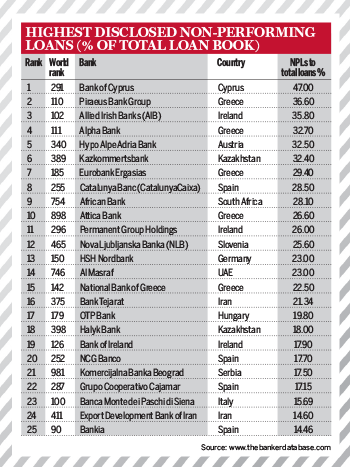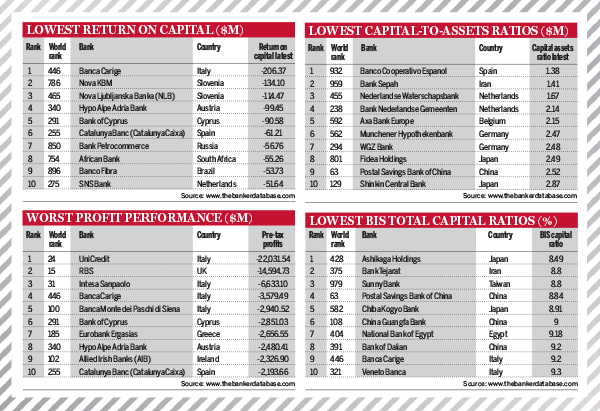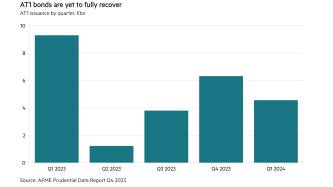The eurozone still dominates the list of negative indicators in this year’s Top 1000 World Banks ranking, including non-performing loans (NPLs) and losses on capital. All five of Greece’s banks are in the top 25 for NPLs, but only one – Eurobank – is still a heavy loss-maker, as the rest have increasingly provisioned for their bad loans. Bank of Cyprus, rescued only in March 2013, tops the table for NPLs and features prominently in terms of total losses and losses on capital.
Philip Alexander reports on the full results of The Banker’s Top 1000 World Banks ranking 2014, in the story Top 1000 World Banks 2014: Back on track?
In some ways, as the crisis in Cyprus was only addressed last year, this is less worrying than the continued problems in Ireland. Allied Irish Banks still has the third highest NPL ratio in the world, while Permanent Group and Bank of Ireland are also in the top 25. AIB also suffers one of the top 10 losses in the Top 1000. The continued losses at Irish banks contrast with the return to profit for Greece, where banks believe NPLs are close to peaking.
Another bank with a long history of crisis is Hypo Alpe Adria, which was rescued by the Austrian government in December 2009. Subsequent investigation revealed widespread fraudulent lending, and the bank has struggled to recover. NPLs are still lodged among the top five in the world, and losses actually worsened in 2013, while the bank’s turnaround chief executive resigned last year. The profitable Austrian operations of the bank were sold to an Indian investor, leaving the more troubled rump of the bank’s activities in central and eastern Europe. In May 2014, the Austrian government announced plans to bail-in the holders of Hypo Alpe Adria subordinated debt, despite guarantees on the debt from the bank’s home province of Carinthia. This is intended to minimise further taxpayer bail-out of the bank, while about €18bn will be transferred into a 'bad bank' structure.
One negative surprise is at African Bank, the specialist consumer lender in South Africa. The bank recorded some of the highest NPL ratios in the world in the past few rankings, but this was in line with a business model based around unsecured retail lending at high interest rates, and the bank reported return on capital in 2013’s ranking that was among the top 25 in the world, at 48%. However, in 2013 this strategy appeared to hit the buffers, with return on capital collapsing to a loss of 55%.
Another new arrival on the negative return on capital list is Bank Petrocommerce in Russia, which has lost more than half its capital. According to ratings agency Moody’s, this was as a result of provisioning for losses on a relatively concentrated corporate loan portfolio. The bank’s shareholders agreed to recapitalise it prior to a takeover by smaller Otkritie. As one of the largest banks in Russia linked to a broader industrial holding company, the sale of Petrocommerce could be a significant pointer for the fate of this type of bank, which is widespread in Russia and frequently affected by high concentration risks.
The list of banks with the lowest capital-to-assets ratios is increasingly dominated by institutions with an unusual business model rather than genuinely undercapitalised banks. These include savings banks such as the Postal Savings Bank of China, utility banks for a group of co-operative banks, such as Shinkin Central Bank in Japan or WGZ in Germany, or state-owned policy lenders such as the two Dutch banks on the list.
All of these entities tend to hold government bonds or other state-guaranteed assets, reducing their risk-based capital needs to very low levels, so that they can run with low leverage ratios. However, the weakness of Bank Sepah in Iran may be more of a concern, given the macroeconomic volatility in the country. In practice, this is a state-owned bank that will be supported by the government. But a 100% devaluation of the Iranian currency in 2013 suggests Iran’s financial sector may well be in need of radical restructuring.











